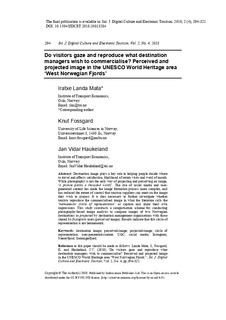| dc.contributor.author | Landa-Mata, Iratxe | |
| dc.contributor.author | Fossgard, Knut | |
| dc.contributor.author | Haukeland, Jan Vidar | |
| dc.coverage.spatial | Norway | nb_NO |
| dc.date.accessioned | 2019-06-28T10:02:27Z | |
| dc.date.available | 2019-06-28T10:02:27Z | |
| dc.date.created | 2018-05-25T08:35:33Z | |
| dc.date.issued | 2018-06-01 | |
| dc.identifier.citation | International Journal of Digital Culture and Electronic Tourism. 2018, 2 (4), 294-321. | nb_NO |
| dc.identifier.issn | 1753-5212 | |
| dc.identifier.uri | http://hdl.handle.net/11250/2602767 | |
| dc.description.abstract | Destination image plays a key role in helping people decide where to travel and affects satisfaction, likelihood of return visits and word of mouth. While photography is not the only way of projecting and perceiving an image, ‘a picture paints a thousand words’. The rise of social media and usergenerated content has made the image formation process more complex, and has reduced the extent of control that tourism suppliers can exert on the image they wish to project. It is thus necessary to further investigate whether tourists reproduce the commercialised image in what the literature calls the ‘hermeneutic circle of representation’ or capture and share their own impressions. This study constructs a categorisation scheme for conducting photography-based image analysis to compare images of two Norwegian destinations as projected by destination management organisations with those shared by Instagram users (perceived image). Results indicate that this circle of representation is not hermeneutic. | nb_NO |
| dc.language.iso | eng | nb_NO |
| dc.publisher | Inderscience Publishers Ltd. | nb_NO |
| dc.rights | Attribution-NonCommercial-NoDerivatives 4.0 Internasjonal | * |
| dc.rights.uri | http://creativecommons.org/licenses/by-nc-nd/4.0/deed.no | * |
| dc.title | Do visitors gaze and reproduce what destination managers wish to commercialise? Perceived and projected image in the UNESCO World Heritage area ‘West Norwegian Fjords’ | nb_NO |
| dc.title.alternative | Do visitors gaze and reproduce what destination managers wish to commercialise? Perceived and projected image in the UNESCO World Heritage area ‘West Norwegian Fjords’ | nb_NO |
| dc.type | Journal article | nb_NO |
| dc.type | Peer reviewed | nb_NO |
| dc.rights.holder | © The Author(s) 2018. Published by Inderscience Publishers Ltd. | nb_NO |
| dc.description.version | submittedVersion | nb_NO |
| cristin.unitcode | 7482,1,3,0 | |
| cristin.unitname | Regional utvikling og reiseliv | |
| cristin.ispublished | false | |
| cristin.fulltext | preprint | |
| cristin.qualitycode | 1 | |
| dc.identifier.doi | 10.1504/IJDCET.2018.10013284 | |
| dc.identifier.cristin | 1586626 | |
| dc.source.journal | International Journal of Digital Culture and Electronic Tourism | nb_NO |
| dc.source.volume | 2 | nb_NO |
| dc.source.issue | 4 | nb_NO |
| dc.source.pagenumber | 294-321 | nb_NO |
| dc.relation.project | Norges forskningsråd: 245325 | nb_NO |

